The Kawasaki Mule 2510 stands out as a robust and reliable utility vehicle, well-suited for a variety of professional and recreational uses, from construction sites to hunting expeditions. Despite its versatility and the power it provides to tackle different terrains and tasks, owners sometimes encounter operational challenges. These issues can range from engine trouble to cooling system malfunctions, potentially affecting the vehicle’s performance.
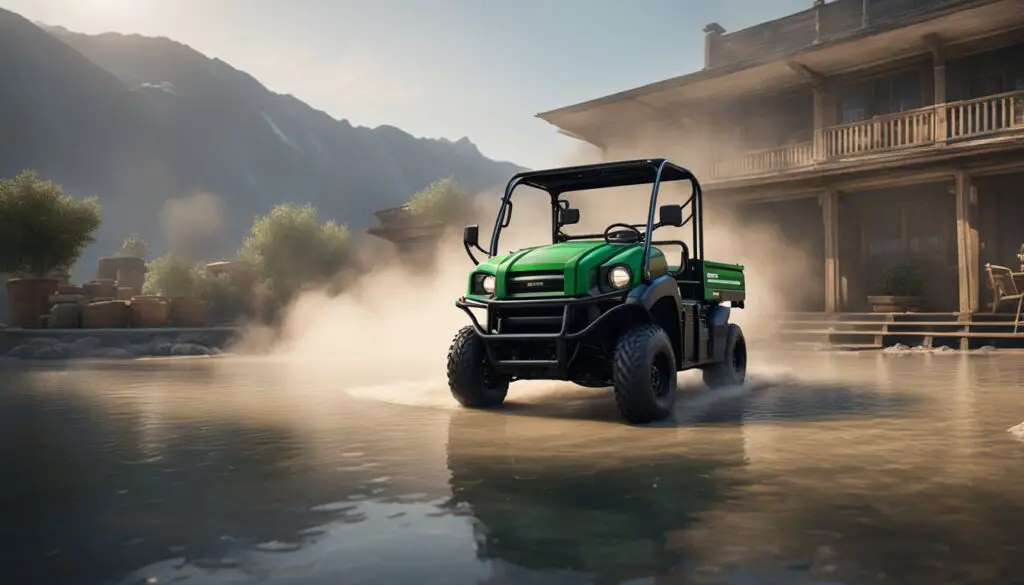
Understanding the common issues faced by the Mule 2510, including those related to the fuel system, electrical components, and drivetrain, helps users identify and resolve problems more efficiently. Additionally, being aware of potential structural concerns, brake system efficiency, and tire maintenance can increase the vehicle’s service life. Regular preventative maintenance, along with addressing frequently asked questions among users, is essential to keep your Kawasaki Mule 2510 ready for action. By staying informed about these concerns, you can ensure that your Mule remains a dependable companion for your outdoor and professional activities.
Key Takeaways
- The Kawasaki Mule 2510 is a versatile utility vehicle prone to certain operational issues.
- Regular maintenance is critical for addressing common problems related to the engine, fuel, and electrical systems.
- Staying informed on vehicle care can enhance performance and longevity for both professionals and enthusiasts.
Common Engine Issues
Your Kawasaki Mule 2510 may face several engine issues that can impact its performance and reliability. Understanding these can help you tackle them more effectively.
Startup Challenges
Ignition system troubles: Your Mule may experience difficulty starting if there’s a problem with the ignition system. Check for spark on both cylinders—if one coil fails, it leads to loss of power. This is because your Mule has two coils, and failure in one results in the affected cylinder not firing.
Fuel system checks: Make sure your fuel pump is functioning correctly. Issues with the carburetor, such as clogging, can also prevent your Mule from starting smoothly.
Overheating Problems
Cooling system maintenance: Overheating can occur if the cooling system is compromised. Ensure the radiator is not faulty or worn out and the coolant level is sufficient.
Checks for overheating:
- Malfunctioning Sensor: Verify the sensor’s functionality.
- Leaking Coolant Tank: Inspect for any signs of leakage or clogging.
- Thermostat: A faulty thermostat needs replacing.
- Cooling Fan: Confirm that the fan operates correctly.
- Water Pump: Damage to the water pump may necessitate repair.
Oil and Lubrication
Regular oil changes are crucial to keep your Mule’s engine running smoothly. Inconsistent oil levels or using the wrong oil can cause significant issues.
Valve clearance: Ensure valve clearances are correct to prevent oil from contaminating the spark plugs, which can lead to white smoke and suboptimal performance.
Oil System Checks:
- Spark Plugs: Look for oil on them, which indicates leaks.
- Compression: Low compression in the cylinders can hint at oil system issues.
Remember, routine maintenance is key to minimizing these common engine issues with your Kawasaki Mule 2510.
Fuel System Troubles
In your Kawasaki Mule 2510, tackling fuel system problems can be as crucial as it is challenging. It’s essential to understand the different aspects of fuel system issues which might include fuel quality, supply, and carburetor malfunction.
Fuel Quality Concerns
Your Mule 2510’s engine health starts with the quality of Gasoline. Using stale or contaminated fuel can lead to performance issues. It’s imperative to ensure your gas is fresh and free from water or debris. If you suspect the Fuel is contaminated, draining the tank and refilling with fresh, high-quality Gas can often resolve many operational hiccups. Remember, the quality of the fuel not only affects startup but also Fuel Efficiency and engine longevity.
Fuel Supply Issues
A key component to check when experiencing supply problems is the Fuel Filter. A clogged filter can restrict flow, reducing Fuel Capacity and efficiency. It’s advisable to replace the fuel filter regularly. Additionally, consider evaluating the fuel lines; cracks or leaks in the Fuel Lines can compromise the fuel system’s integrity, leading to reduced pressure and flow to the engine.
Carburetion Complexities
The carburetor is complex but vital. If your Mule 2510 starts and then stalls, or runs irregularly, the carburetor may need attention. Ensure that it is clean and that all passages are clear to allow for proper fuel passage. Issues with the carburetor could involve clogged jets, incorrect float levels, or worn components. Regular maintenance, such as disassembling, cleaning, and replacing worn out parts, can help maintain proper fuel-air mixture and engine performance.
Electrical Components
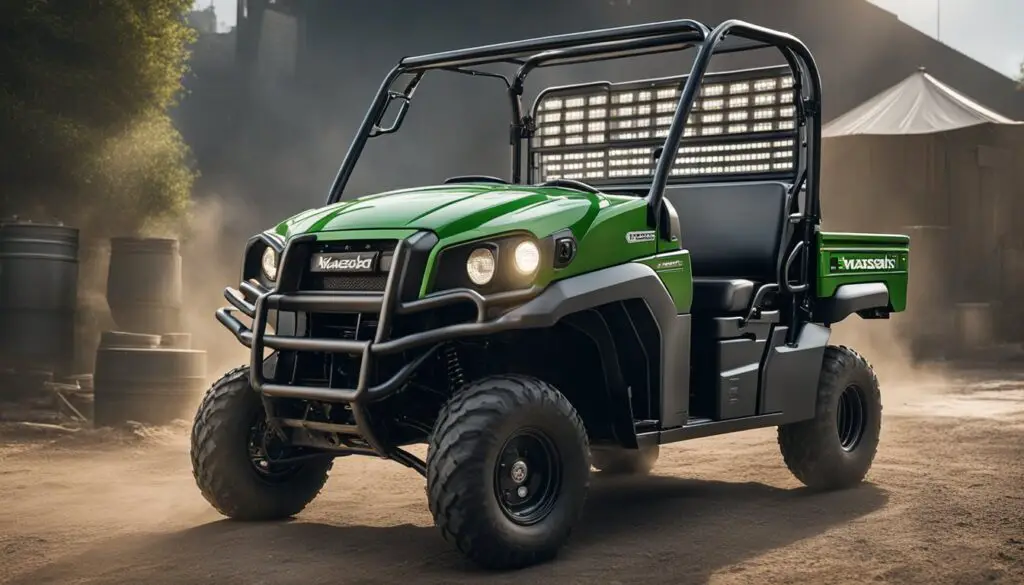
When troubleshooting the Kawasaki Mule 2510, you’ll find that electrical issues can often be traced back to a few key components. Your understanding of these can save you time and money.
Battery Performance
Battery health is crucial for your Mule to start and run smoothly. Ensure your battery is fully charged and can hold that charge; a weak battery might power lights but fail to turn the engine over. Check:
- Voltage: Should read around 12.6 volts when fully charged.
- Terminals: Clean any corrosion with a wire brush.
- Connections: Ensure they are tight and secure.
Charging System Checks
Your Mule’s alternator, or charging system, is responsible for keeping the battery topped up while it’s running. Perform a visual inspection of the wires and connections for any wear or damage. You can use a multimeter to measure the charging system’s output — typically you should see between 13.8 and 14.2 volts when the engine is running.
Ignition Switch Woes
A faulty ignition switch can cause intermittent starting issues. Symptoms may include difficulty in turning the key or the engine failing to crank despite a good battery. Inspect the wires connected to the ignition switch for damage, and test the coils to ensure they are functioning properly. A professional diagnosis might be necessary if you’re uncomfortable with electrical diagnostics.
Drivetrain and Transmission

Your Kawasaki Mule 2510 may face a series of drivetrain and transmission issues that can impact its performance. From transmission difficulties to clutch engagement and the functionality of the four-wheel drive, each component plays a critical role in your vehicle’s operation.
Transmission Difficulties
The transmission is central to your Mule’s performance and, if problematic, can manifest through symptoms such as gears popping out. This could indicate internal wear or a misalignment of components. It’s important to inspect the transmission components for any signs of damage or excessive wear and ensure that they are properly engaged and lubricated.
Clutch Engagement
Clutch engagement issues can cause your Mule to have a delayed or rough start. A common complaint may involve the engine revving without corresponding acceleration, often pointing to a clutch that doesn’t engage or disengage smoothly. Regular maintenance and inspection are paramount for clutch health, including checking the clutch for dirt or wear and adjusting as needed for optimal performance.
Four-Wheel Drive Functionality
Your Mule’s 4WD capability is essential for tough terrain. Problems with the four-wheel drive functionality tend to arise from faulty transmission linkages or issues with the differential. Ensure that the cables activating the transmission for the 4WD are functioning properly and the differential is not causing drag, which might prevent the front wheels from engaging as they should. Pay close attention to the torque delivery in each drive mode—whether it’s 2WD or 4WD—to gauge the health of the drivetrain.
It’s crucial to keep an eye on the four-wheel hydraulic brakes as part of your drivetrain maintenance, as they are integral to the handling and safety of your vehicle. Regularly check the brake system for any signs of hydraulic fluid leakage or wear on the brake pads.
Cooling and Ventilation System
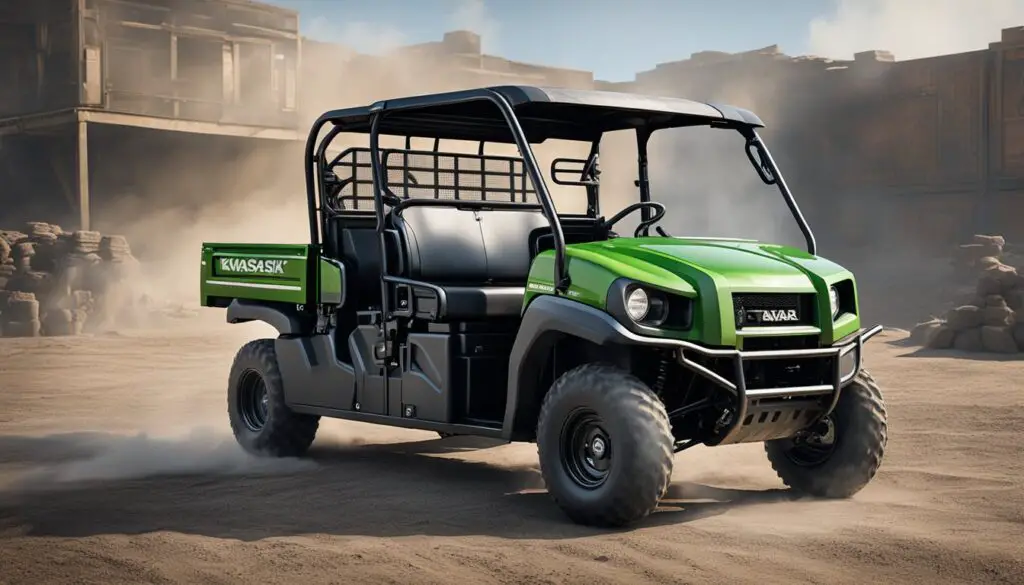
Maintaining optimal temperature in your Kawasaki Mule 2510 is crucial for its performance. Let’s explore the key components of the cooling and ventilation system to ensure your Mule runs smoothly and efficiently.
Radiator Efficiency
Your Mule’s radiator is the central component in managing engine temperature. Ensure it’s free from debris and dirt which can impede airflow and reduce cooling efficiency. Regularly check for blockages and clean the fins carefully with a soft brush or compressed air. If overheating persists, consider inspecting for internal radiator clogs, as these can also hinder heat dissipation.
Coolant Level Maintenance
Adequate coolant levels are essential for heat transfer. Always keep an eye on the coolant level in the reservoir, and top it up if necessary. Remember, it’s not just about quantity; the quality of your coolant also matters. Ensure you’re using the correct type of coolant as specified in your Mule’s manual and replace it according to the recommended schedule.
- Check Coolant Levels:
- Cold Engine: Before starting, ensure the engine is cool.
- Reservoir: Inspect the coolant reservoir and fill to the indicated line if low.
Thermostat Operation
The thermostat regulates the flow of coolant to maintain a consistent operating temperature. If your Mule is overheating, the thermostat may be stuck closed. Conversely, if it’s stuck open, the engine may not reach the proper operating temperature, which can also lead to performance issues.
- Symptoms of Thermostat Failure:
- Overheating quickly after starting
- Fluctuating temperature gauge
Always assess the thermostat’s functionality during coolant system maintenance or if you experience temperature irregularities.
Structural Integrity
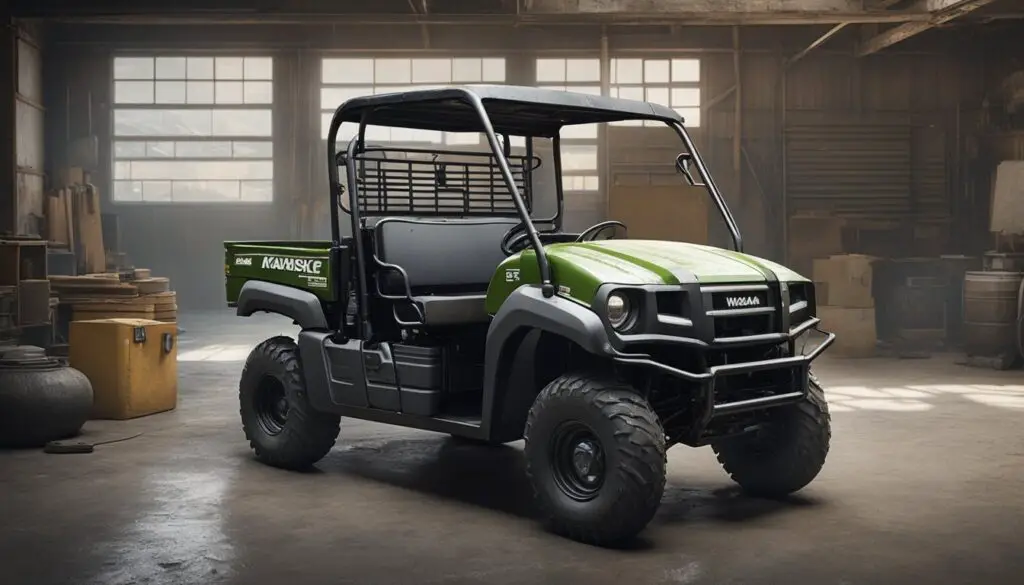
When maintaining your Kawasaki Mule 2510, paying close attention to the structural integrity is crucial. This encompasses not only the chassis and frame stability but also ensuring that rust and corrosion are kept at bay, and that the suspension system is regularly checked.
Chassis and Frame Stability
The chassis is the foundation of your Mule 2510, directly affecting Ground Clearance and Load Capacity. You should routinely inspect the frame for any signs of damage or undue flexing, especially if you frequently navigate uneven terrain.
- Checkpoints for Stability:
- Ensure there are no visible cracks or bends.
- Verify all bolts and fixtures are tightened properly.
Rust and Corrosion
Rust and corrosion can compromise the structural integrity of your vehicle over time. Areas prone to moisture or chipping paint are potential hotspots for rust.
- Prevention Tips:
- Regularly clean your Mule to remove dirt and debris.
- Touch up any chips in the paint promptly.
Suspension System Checks
A properly functioning suspension system is integral for a smooth and stable ride. Regular checks can prevent unexpected issues.
- Suspension Inspection:
- Look for signs of wear or damage on shock absorbers.
- Check the springs for sagging or deformation, which might impact load capacity.
Braking System
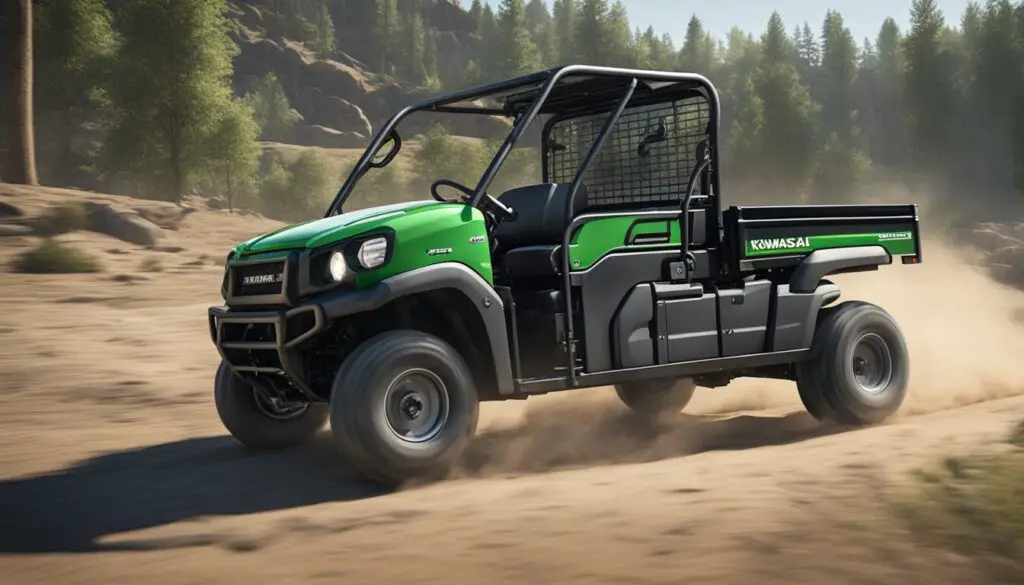
Your Kawasaki Mule 2510 relies on a dependable braking system to ensure your safety while operating the vehicle. It’s important to be aware of the subsystems: the hydraulic brakes responsible for generating the necessary pressure, and the brake pads and discs that play a crucial role in bringing you to a stop.
Hydraulic Brakes
Your Mule’s hydraulic brakes are a key component of the all-wheel braking system, utilizing fluid to transmit brake force. If you’re experiencing loss of brake pressure, the usual suspects include deteriorating master cylinders or air in the brake lines. While the latter can be remedied through proper bleeding of the brake system, a faulty master cylinder, as some users have reported, must be replaced to restore proper brake function.
Brake Pads and Discs
Regular inspection of your brake pads and discs is essential. Worn out pads or damaged discs can significantly reduce braking efficiency and may even lead to a complete loss of brake function. In your Mule 2510, brake pads should exhibit an even wear and be replaced before they thin to less than 1/8 inch, while brake discs require a smooth surface free from deep grooves or significant wear patterns.
Wheels and Tires
Maintaining the tires and ensuring proper wheel alignment are vital for your Kawasaki Mule 2510’s performance and top speed. Let’s dive into how you can keep your wheels and tires in tip-top shape.
Tire Maintenance
Proper tire maintenance is crucial for keeping your Mule 2510 running smoothly and achieving its top speed. Check your tire pressure regularly, as incorrect tire pressure can lead to uneven tire wear and affect the vehicle’s stability. The optimal tire pressure for the front tires is generally around 12 psi, while the rear tires should be closer to 24 psi.
- Inspect tires for wear: Look for signs of uneven wear, which might suggest alignment issues.
- Rotate your tires: Periodically rotating your tires can help them wear more evenly, which prolongs their lifespan.
- Tire replacement: If your tires are worn or damaged, replacing them is essential. Tires up to 29×12 inches can fit with modifications like a lift and wheel spacers, and 26×12 inches tires might require spacers depending on the width.
Wheel Alignment
Proper wheel alignment ensures optimal handling and tire longevity. If your Mule 2510 is pulling to one side or you notice uneven tire wear, it might be time for an alignment check.
- Inspect suspension: Worn-out components like ball joints or tie rods can result in misalignment.
- Regular checks: Have your alignment checked by professionals if you encounter steering difficulties or after installing new tires.
By keeping a close eye on these aspects, you’ll not only enjoy a smoother ride but also protect your Mule 2510 from unnecessary wear.
Preventative Maintenance and Service
Maintaining your Kawasaki Mule 2510 is key to ensuring it operates effectively and lasts a long time. Follow the Service Manual for regular service intervals and take care of user-serviceable items to avoid common issues.
Regular Service Intervals
Consult your Service Manual for the recommended maintenance schedule. Ensure that you adhere to these intervals for professional servicing. A certified mechanic can spot early signs of wear and perform necessary troubleshooting. For example:
- Engine oil change: Conduct this after every 20 hours of operation or approximately 120 miles.
- Transmission fluid: Regular checks can prevent shifting difficulties. Look for signs like grinding noises or hesitancy in gear engagement.
Remember that proper maintenance can relate directly to the equipment’s towing capacity. Overworking an under-serviced Mule 2510 could lead to performance issues.
User-Serviceable Items
There are several maintenance tasks that you can perform to help keep your Mule in top shape:
- Filters: Regularly check and replace air and fuel filters to prevent debris from impairing your Mule’s performance.
- V-Twin engine care: Ensure the V-Twin engine’s cooling fins are clear of debris and the cooling system is functioning correctly.
- General inspection: Before operation, inspect for any loose bolts, worn components, or signs of damage that can be spotted and corrected early on.
By keeping up with these service elements, you can significantly reduce the likelihood of experiencing problems with your Kawasaki Mule 2510.
Frequently Asked Questions
In this section, you’ll find answers to common issues related to the Kawasaki Mule 2510. We cover everything from carburetor troubles to electrical problems, providing tips to help you troubleshoot effectively.
What are some common issues owners face with the carburetor on a Kawasaki Mule 2510?
Your Mule 2510’s carburetor might encounter problems such as difficulty in starting, irregular idling, or poor engine performance. These can be due to clogging, improper fuel mixture, or vacuum leaks.
How can I troubleshoot transmission problems in my Kawasaki Mule 2510?
Transmission issues may present as gear shifting difficulties or strange noises. Check the transmission fluid level, inspect the clutch for wear, and examine the gearbox for any signs of damage.
What should I check for when experiencing engine trouble in my Kawasaki Mule 2510?
When your Kawasaki Mule 2510 has engine problems, consider checking the spark plug for carbon buildup, the air filter for blockages, and ensure the fuel system is delivering gas efficiently. Overheating might also be caused by faulty cooling components.
Can you list typical reasons a Kawasaki Mule 2510 might fail to start?
Common starting problems could stem from a drained battery, faulty ignition switch, or bad starter motor. Also examine the starter relay and solenoid for potential issues.
What maintenance tips can help prevent frequent problems with the Kawasaki Mule 2510?
Preventative maintenance is key. Regularly change the oil, clean or replace the air filter, check the tire pressure, and ensure the brakes are in good working condition to avoid common issues.
Are there known electrical problems that affect the Kawasaki Mule 2510, and how can I fix them?
Electrical issues might include failing lights, non-responsive ignition, or erratic instrument panel readings. Start by checking the battery’s charge, look for any loose or corroded connections, and inspect the fuses and wiring harnesses.
